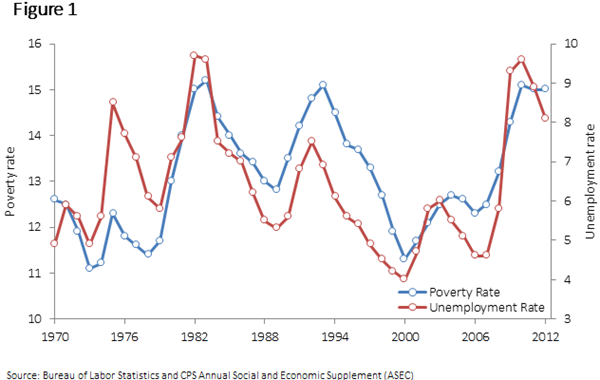 If you’re out of work and can’t earn an income, it’s easy to slide down the economic ladder from working-poor to just plain poor. So it’s no surprise that the poverty rate in America has, since at least 1970, moved in sync with the unemployment rate. During each recession we would see a spike in the poverty rate and then a decline as the economy recovers and employment levels began to rise.
If you’re out of work and can’t earn an income, it’s easy to slide down the economic ladder from working-poor to just plain poor. So it’s no surprise that the poverty rate in America has, since at least 1970, moved in sync with the unemployment rate. During each recession we would see a spike in the poverty rate and then a decline as the economy recovers and employment levels began to rise.
But around 2010, something seems to have changed. A decrease in unemployment is now no longer enough to reduce the poverty rate. According to a new memo by the Brookings Institute,
Between 2010 and 2013, the unemployment rate fell by 23% in the United States. The poverty rate, we predict, will have fallen by only one percent over the same time period. That is, for a second year in a row, we expect no significant change in either the poverty rate for all persons or for children. [emphasis in original]

The report also predicts the poverty rate likely won’t drop to pre-2007 levels anytime in the next decade:
We predict that there will be a gradual decline in the headline poverty rate for the foreseeable future; however, we do not expect it to return to its pre-Great Recession level by 2024 despite the fact the unemployment rate is projected to do so. This finding reinforces the idea that there are other significant drivers of the poverty rate in addition to the state of the job market—specifically, the composition of families and the generosity of the safety net.
The findings align with what many family scholars and economists have been predicting: the decline of marriage leads to an increase in poverty.
From 2007 to 2011, the American population increased by 10,360,000 while the number of marriages decreased during that same period by 79,000. Over the last few years we’ve seen the same trend: more people, fewer marriages.
The poverty rate among married couples is less than half the average (about 6 percent). And for married couples who both have full-time jobs, the rate is almost non-existent (0.001 percent). The rate for single parents, though, is about 4 to 5 times higher than for married couples (25 percent among single dads and 31 percent among single moms).
The effect of the decline in marriage, coupled with a increase in single parenthood, is that many more children live in poverty than they would if marriage was more common. As the Heritage Foundation reports, marriage is the greatest weapon against child poverty:
The collapse of marriage, along with a dramatic rise in births to single women, is the most important cause of childhood poverty—but government policy doesn’t reflect that reality, according to a special report released today by The Heritage Foundation.
Nearly three out of four poor families with children in America are headed by single parents. When a child’s father is married to his mother, however, the probability of the child’s living in poverty drops by 82 percent.
Wherever we look—whether in the streets or the social science research—we find confirmation that the breakdown of the family is correlated with societal ills such as poverty. We know the cause and we know the cure. But do we have the will as a nation to do what will be required to discourage divorce and single parenthood and encourage the development of strong marriages?

